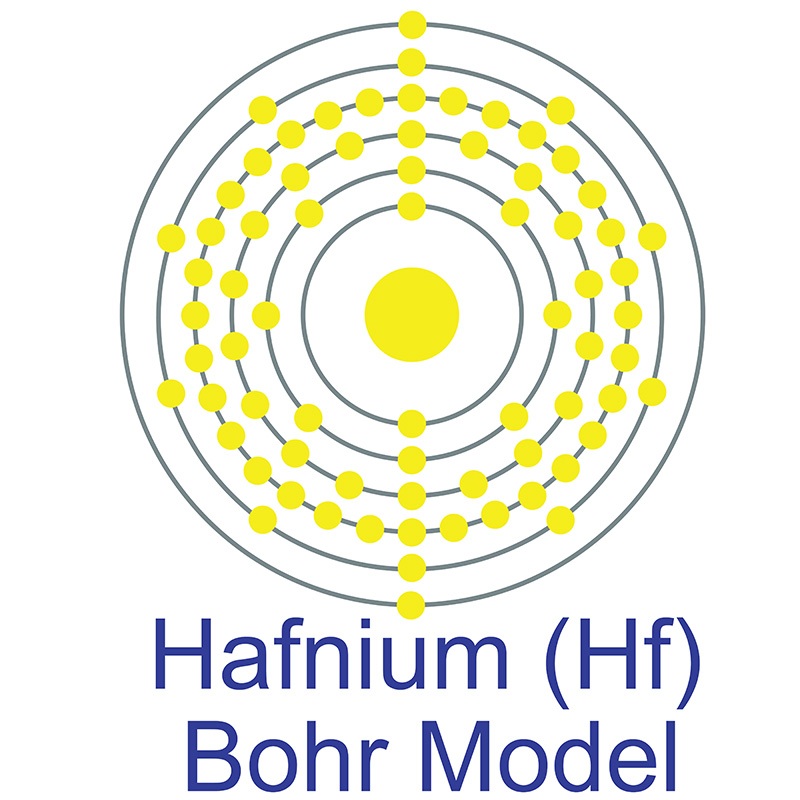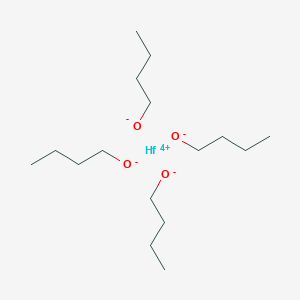SECTION 1. IDENTIFICATION
Product Name: Hafnium(IV) n-butoxide
Product Number: All applicable American Elements product codes, e.g. HF4-NBBOX-02
, HF4-NBBOX-03
, HF4-NBBOX-04
, HF4-NBBOX-05
CAS #: 22411-22-9
Relevant identified uses of the substance: Scientific research and development
Supplier details:
American Elements
10884 Weyburn Ave.
Los Angeles, CA 90024
Tel: +1 310-208-0551
Fax: +1 310-208-0351
Emergency telephone number:
Domestic, North America: +1 800-424-9300
International: +1 703-527-3887
SECTION 2. HAZARDS IDENTIFICATION
Classification of the substance or mixture
GHS Classification in accordance with 29 CFR 1910 (OSHA HCS)
Flammable liquids(Category 3), H226
Serious eye damage(Category 1), H318
Skin sensitisation(Category 1), H317
GHS Label elements, including precautionary statements
Pictogram
Signal word
Danger
Hazard statement(s)
H226
Flammable liquid and vapor.
H317
May cause an allergic skin reaction.
H318
Causes serious eye damage.
Precautionary statement(s)
P210
Keep away from heat/sparks/open flames/hot surfaces. No smoking.
P233
Keep container tightly closed.
P240
Ground/bond container and receiving equipment.
P241
Use explosion-proof electrical/ ventilating/ lighting/ equipment.
P242
Use only non-sparking tools.
P243
Take precautionary measures against static discharge.
P261
Avoid breathing dust/ fume/ gas/ mist/ Vapors/ spray.
P272
Contaminated work clothing should not be allowed out of the workplace.
P280
Wear protective gloves/ protective clothing/ eye protection/ face protection.
P303 + P361 + P353
IF ON SKIN (or hair): Remove/ Take off immediately all contaminated clothing. Rinse skin with water/ shower.
P305 + P351 + P338
IF IN EYES: Rinse cautiously with water for several minutes. Remove contact lenses, if present and easy to do. Continue rinsing.
P310
Immediately call a POISON CENTER/doctor.
P321
Specific treatment (see supplemental first aid instructions on this label).
P333 + P313
If skin irritation or rash occurs: Get medical advice/ attention.
P363
Wash contaminated clothing before reuse.
P370 + P378
In case of fire: Use dry sand, dry chemical or alcohol-resistant foam for extinction.
P403 + P235
Store in a well-ventilated place. Keep cool.
P501
Dispose of contents/ container to an approved waste disposal plant.
Hazards not otherwise classified (HNOC) or not covered by GHS-none
SECTION 3. COMPOSITION/INFORMATION ON INGREDIENTS
Mixtures
Synonyms:Tetrabutoxyhafnium(IV)
n-Butoxy hafnium
Formula: C16H36HfO4
Molecular weight: 470.94 g/mol
SECTION 4. FIRST AID MEASURES
Description of first aid measures
General advice
Consult a physician. Show this safety data sheet to the doctor in attendance.
Move out of dangerous area.
If inhaled
If breathed in, move person into fresh air. If not breathing, give artificial respiration. Consult a physician.
In case of skin contact
Wash off with soap and plenty of water. Consult a physician.
In case of eye contact
Rinse thoroughly with plenty of water for at least 15 minutes and consult a physician.
If swallowed
Do NOT induce vomiting. Never give anything by mouth to an unconscious person. Rinse mouth with water. Consult a physician.
Most important symptoms and effects, both acute and delayed
The most important known symptoms and effects are described in the labelling (see section 2) and/or in section 11
Indication of any immediate medical attention and special treatment needed
No data available
SECTION 5. FIREFIGHTING MEASURES
Extinguishing media
Suitable extinguishing media
Use water spray, alcohol-resistant foam, dry chemical or carbon dioxide.
Special hazards arising from the substance or mixture
No data available
Advice for firefighters
Wear self-contained breathing apparatus for firefighting if necessary.
Further information
Use water spray to cool unopened containers.
SECTION 6. ACCIDENTAL RELEASE MEASURES
Personal precautions, protective equipment and emergency procedures
Use personal protective equipment. Avoid breathing Vapors, mist or gas. Ensure adequate ventilation. Remove all sources of ignition. Evacuate personnel to safe areas. Beware of Vapors accumulating to form explosive concentrations. Vapors can accumulate in low areas.
For personal protection see section 8.
Environmental precautions
Prevent further leakage or spillage if safe to do so. Do not let product enter drains.
Methods and materials for containment and cleaning up
Contain spillage, and then collect with an electrically protected vacuum cleaner or by wet-brushing and place in container for disposal according to local regulations (see section 13).
Reference to other sections
For disposal see section 13.
SECTION 7. HANDLING AND STORAGE
Precautions for safe handling
Avoid contact with skin and eyes. Avoid inhalation of Vapor or mist.
Keep away from sources of ignition -No smoking.Take measures to prevent the build up of electrostatic charge.
For precautions see section 2.
Conditions for safe storage, including any incompatibilities
Keep container tightly closed in a dry and well-ventilated place.
Containers which are opened must be carefully resealed and kept upright to prevent leakage.
Moisture sensitive.
Handle and store under inert gas.
Specific end use(s)
Apart from the uses mentioned in section 1 no other specific uses are stipulated
SECTION 8. EXPOSURE CONTROLS/PERSONAL PROTECTION
Exposure controls
Appropriate engineering controls
Handle in accordance with good industrial hygiene and safety practice. Wash hands before breaks and at the end of workday.
Personal protective equipment
Eye/face protection
Tightly fitting safety goggles. Faceshield (8-inch minimum). Use equipment for eye protection tested and approved under appropriate government standards such as NIOSH (US) or EN 166(EU).
Skin protection
Handle with gloves. Gloves must be inspected prior to use. Use proper glove removal technique (without touching glove's outer surface) to avoid skin contact with this product. Dispose of contaminated gloves after use in accordance with applicable laws and good laboratory practices. Wash and dry hands.
Body Protection
Complete suit protecting against chemicals, Flame retardant antistatic protective clothing., The type of protective equipment must be selected according to the concentration and amount of the
dangerous substance at the specific workplace.
Respiratory protection
Where risk assessment shows air-purifying respirators are appropriate use a full-face respirator with multi-purpose combination (US) or type ABEK (EN 14387) respirator cartridges as a backup to engineering controls.
If the respirator is the sole means of protection, use a full-face supplied air respirator. Use respirators and components tested and approved under appropriate government standards such as NIOSH (US) or CEN (EU).
Control of environmental exposure
Prevent further leakage or spillage if safe to do so. Do not let product enter drains.
SECTION 9. PHYSICAL AND CHEMICAL PROPERTIES
Information on basic physical and chemical properties
Appearance
Form: liquid
Colour: colourless
Odor
No data available
Odor Threshold
No data available
pH
No data available
Melting point/freezing point
No data available
Initial boiling point and boiling range
No data available
Flash point
35 °C (95 °F)
Evaporation rate
No data available
Flammability (solid, gas)
No data available
Upper/lower flammability or explosive limits
No data available
Vapor pressure
No data available
Vapor density
No data available
Relative density
1.2376 g/mL
Water solubility
No data available
Partition coefficient: n-octanol/water
No data available
Auto-ignition temperature
The substance or mixture is not classified as self heating.
Decomposition temperature
No data available
Viscosity
No data available
Explosive properties
No data available
Oxidizing properties
No data available
Other safety information
No data available
SECTION 10. STABILITY AND REACTIVITY
Reactivity
No data available
Chemical stability
Stable under recommended storage conditions.
Possibility of hazardous reactions
Vapors may form explosive mixture with air.
Conditions to avoid
Heat, flames and sparks.
Incompatible materials
Alcohols, Ketones, Strong oxidizing agents
Hazardous decomposition products
Hazardous decomposition products formed under fire conditions.
-Carbon oxides, Zirconium oxides, Hafnium oxide
Other decomposition products
-No data available
In the event of fire: see section 5
SECTION 11. TOXICOLOGICAL INFORMATION
Information on toxicological effects
Acute toxicity
No data available
Inhalation: No data available
Dermal: No data available
No data available
Skin corrosion/irritation
No data available
Serious eye damage/eye irritation
No data available
Respiratory or skin sensitisation
Germ cell mutagenicity
No data available
Carcinogenicity
IARC:
No component of this product present at levels greater than or equal to 0.1% is identified as
probable, possible or confirmed human carcinogen by IARC.
NTP:
No component of this product present at levels greater than or equal to 0.1% is identified as a
known or anticipated carcinogen by NTP.
OSHA:
No component of this product present at levels greater than or equal to 0.1% is identified as a
carcinogen or potential carcinogen by OSHA.
Reproductive toxicity
No data available
No data available
Specific target organ toxicity -single exposure
No data available
Specific target organ toxicity -repeated exposure
No data available
Aspiration hazard
No data available
Additional Information
RTECS: Not available
To the best of our knowledge, the chemical, physical, and toxicological properties have not been thoroughly investigated.
SECTION 12. ECOLOGICAL INFORMATION
Toxicity
No data available
Persistence and degradability
No data available
Bioaccumulative potential
No data available
Mobility in soil
No data available
Results of PBT and vPvB assessment
PBT/vPvB assessment not available as chemical safety assessment not required/not conducted
Other adverse effects
No data available
SECTION 13. DISPOSAL CONSIDERATIONS
Waste treatment methods
Product
Burn in a chemical incinerator equipped with an afterburner and scrubber but exert extra care in igniting as this material is highly flammable.
Offer surplus and non-recyclable solutions to a licensed disposal company.
Contact a licensed professional waste disposal service to dispose of this material.
Contaminated packaging
Dispose of as unused product.
SECTION 14. TRANSPORT INFORMATION
DOT (US)
UN number:1993
Class: 3
Packing group: III
Proper shipping name: Flammable liquids, n.o.s.(Hafnium(IV) n-butoxide)
Reportable Quantity(RQ): 100 lbs
Poison Inhalation Hazard: No
IMDG
UN number: 1993
Class: 3
Packing group: III
EMS-No: F-E, S-E
Proper shipping name: FLAMMABLE LIQUID, N.O.S.(Hafnium(IV) n-butoxide)
IATA
UN number:1993
Class: 3
Packing group: III
Proper shipping name: Flammable liquid, n.o.s.(Hafnium(IV) n-butoxide)
SECTION 15. REGULATORY INFORMATION
SARA 302 Components
No chemicals in this material are subject to the reporting requirements of SARA Title III, Section 302.
SARA 313 Components
This material does not contain any chemical components with known CAS numbers that exceed the threshold (De Minimis) reporting levels established by SARA Title III, Section 313.
SARA 311/312 Hazards
Fire Hazard, Acute Health Hazard, Chronic Health Hazard
Massachusetts Right To Know Components
No components are subject to the Massachusetts Right to Know Act.
Pennsylvania Right To Know Components
Hafnium(IV) n-butoxide
CAS-No.
22411-22-9
Revision Date
Zirconium
7440-67-7
1991-07-01
New Jersey Right To Know Components
Hafnium(IV) n-butoxide
CAS-No.
22411-22-9
Revision Date
Zirconium
7440-67-7
1991-07-01
California Prop. 65 Components
This product does not contain any chemicals known to State of California to cause cancer, birth defects, or any other reproductive harm.
SECTION 16. OTHER INFORMATION
Safety Data Sheet according to Regulation (EC) No. 1907/2006 (REACH). The above information is believed to be correct but does not purport to be all inclusive and shall be used only as a guide. The information in this document is based on the present state of our knowledge and is applicable to the product with regard to appropriate safety precautions. It does not represent any guarantee of the properties of the product. American Elements shall not be held liable for any damage resulting from handling or from contact with the above product. See reverse side of invoice or packing slip for additional terms and conditions of sale. COPYRIGHT 1997-2022 AMERICAN ELEMENTS. LICENSED GRANTED TO MAKE UNLIMITED PAPER COPIES FOR INTERNAL USE ONLY.
 The number of electrons in each of Hafnium's shells is 2, 8, 18, 32, 10, 2 and its electron configuration is [Xe] 4f14 5d2 6s2. The hafnium atom has a radius of 159 pm and a Van der Waals radius of 212 pm. Hafnium was predicted by Dmitri Mendeleev in 1869 but it was not until 1922 that it was first isolated Dirk Coster and George de Hevesy. In its elemental form, hafnium has a lustrous silvery-gray appearance.
The number of electrons in each of Hafnium's shells is 2, 8, 18, 32, 10, 2 and its electron configuration is [Xe] 4f14 5d2 6s2. The hafnium atom has a radius of 159 pm and a Van der Waals radius of 212 pm. Hafnium was predicted by Dmitri Mendeleev in 1869 but it was not until 1922 that it was first isolated Dirk Coster and George de Hevesy. In its elemental form, hafnium has a lustrous silvery-gray appearance.  Hafnium does not exist as a free element in nature. It is found in
Hafnium does not exist as a free element in nature. It is found in 
